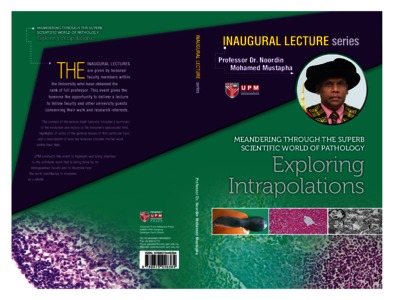Citation
Mohamed Mustapha, Noordin
(2016)
Meandering through the superb scientific world of pathology: exploring intrapolations.
[Inaugural Lecture]
Abstract
Although literally pathology can be defined as the “study of sufferings”, it by no means signifies that a pathologist benefits by seeing an individual enduring pain from an ailment. In fact, many regard pathology as the turning point of life and it is usually dubbed as “The field where herein death rejoices to aid the living”. Indeed, a very true slogan since pathology assists in explaining the cause and mechanism of death. Through this process of pathogenesis or pathophysiology, the outcome (between the interaction of host, environment and agent) is used to develop an effective treatment, control and prevention regime. An old branch of biological science, pathology works closely with the other “physical” components of chemistry and physics to elucidate an abnormality. The needs of these two physical science components is inevitable in explaining pathologies dealing with haemodynamics of blood flow, aerodynamics of particulates, phagocytic activity, metabolic derangements, action potential, forensic investigation and many others. In actual fact, it forms the backbone of Koch’s postulate which, currently, either willingly or otherwise, is used in most biological research models. This includes that of infectious (from the novel prion to naked-eye parasites), metabolic, endocrinebased or toxic (all forms) origin. Most biomedical-based research relies on inventing a functional model of a disease or condition. This can only be conclusively verified using pathology where even failure to elicit biochemical changes by the body can be detected at either the microscopic or ultrastructural level. Currently, many regard pathology as a study of pre-disease condition where through biopsies, an effective treatment, control, prevention and a prognosis can be derived.
Furthermore, pathology at almost all levels, is the only field that can state if a change in a tissue is a lesion, artifact or post mortem effect. This is of utmost importance in both research and forensic investigation. Nevertheless, despite no changes or new additions made in the terminologies used, it still remains valid and has kept itself abreast with developments in molecular and nanotechnological sciences. This has given rise to the birth of many newer branches of pathology that employ molecular techniques and nanotechnology in arriving at a confirmed diagnosis. In the medical context, the historic notion that pathology is involved with death or post mortem is currently irrelevant as mentioned earlier, since it has been successfully exploited to detect states of pre-disease conditions.
Likewise in research, pathology is not just a tool but rather an inevitable adjunct for excellence where a postulated functional model is being proven. Indirectly, while known to be associated with a non-living soul, a pathologist is an indispensable research partner in many of today’s research. This review will try to illustrate the significance of the meandering path taken by pathology in the ever changing world of research and diagnosis. Examples used will be those encountered in our quest to solve problems in toxicology, forensics, environmental pollution, emerging and re-emerging diseases and the development of new nutraceutical products. It is clearly discernible that pathology was, is and will still remain as an important component in most biological science research as will be exemplified in this review.
Pathology has helped many to achieve breakthroughs in toxicology, forensic science, environmental issues, nutraceutical and transboundary disease investigations. In Brachiaria decumbens toxicity, the mechanism of liver damage and associated signs were elucidated. The use of pathology in forensic investigation attempted to estimate the time of death following the advent of virtopsy in the veterinary field. It was found that the air pollutants, especially that of PM2.5, can lead to acute and chronic changes in the lung while garlic and blackseed can alleviate these changes. Zerumbone is an effective compound that could reverse artheroscelerotic changes.
Download File
![[img]](http://psasir.upm.edu.my/58816/1.hassmallThumbnailVersion/20170731174712MEANDERING_THROUGH_THE_SUPERB_SCIENTIFIC_WORLD_OF_PATHOLOGY_Exploring_Intrapolations_.pdf)  Preview |
|
Text
20170731174712MEANDERING_THROUGH_THE_SUPERB_SCIENTIFIC_WORLD_OF_PATHOLOGY_Exploring_Intrapolations_.pdf
Download (9MB)
| Preview
|
|
Additional Metadata
Actions (login required)
 |
View Item |

